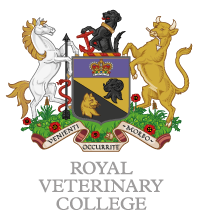Royal Veterinary College
 |
|
| Motto | Latin: Venienti Occurrite Morbo |
|---|---|
|
Motto in English
|
Confront disease at its onset |
| Type | Public veterinary school |
| Established | 1791 (became a constituent part of University of London in 1949) |
| Chancellor | HRH The Princess Royal (University of London) |
| Principal | Stuart Reid |
| Students | 2,145 (2014/15) |
| Undergraduates | 1,635 (2014/15) |
| Postgraduates | 510 (2014/15) |
| Location | London and Hertfordshire, United Kingdom |
| Campus | Urban |
| Colours | |
| Affiliations | University of London |
| Website | www.rvc.ac.uk/ |
 |
|
|
THE (2016/17, national) |
46 |
|---|---|
|
THE (2016/17, world) |
301-350 |
The Royal Veterinary College (informally the RVC) is a veterinary school located in London and a constituent college of the federal University of London. The RVC was founded in 1791 and joined the University of London in 1949. It is the oldest and largest veterinary school in the United Kingdom, and one of only eight in the country where students can study to become a vet.
The Veterinary College of London was founded in 1792 by a group led by Granville Penn, a grandson of William Penn, following the foundation of the first veterinary college in Europe in Lyon, France in 1762. The promoters wished to select a site close to the metropolis, but far enough away to minimise the temptations open to the students. Earl Camden was just then making arrangements to develop some fields he owned to the north of London, and he replied to the College's newspaper advertisement for a suitable site with an offer to sell it some of his land. The site was rural, but urban developments appeared on all sides in the early decades of the 19th century, creating Camden Town.
Charles Benoit Vial de St Bel of the Lyon establishment was appointed as the first principal of the new college. The first students, just four of them, began their studies in 1792, and the first horse was admitted for treatment in 1793. St Bel died later that year and was succeeded by Edward Coleman, who managed the college for nearly forty six years and established its reputation. Among the first students were Delabere Pritchett Blaine and Bracy Clark. In its early years it was mainly concerned with horses, but the range of animals covered gradually increased. The original building was a quadrangle in a neoclassical style, and there was a paddock on the opposite side of Royal College Street, but this was later sold for housing development.
In 1796 John Shipp was the first qualified veterinary surgeon to join the British Army.
...
Wikipedia
